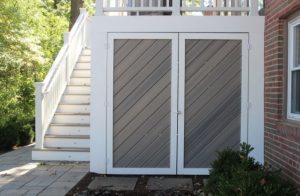Those spare Allen wrenches and $1 tape measure from Ikea aren’t going to cut it if you’re making real home improvements.
Here are the nine essential tools you need to start hammering out great projects:
#1 Two Hammers
You know you need a hammer. Duh.
But Beth Allen, a licensed contractor and DIY instructor, is about to blow your mind: You don’t need a hammer. You need two.
A lightweight hammer is important for more delicate projects, like adding trim to a bookcase (without the fear of splitting said trim) or putting a nail into drywall.
“Heck, I’ve used a shoe for that kind of hammering,” says Allen, which gives you an idea of how lightweight we’re talking. “You can even use the floral hammer that comes in those ‘lady’ toolsets.”
But don’t let that be your only one: You’ll need a heavy-duty hammer for nailing into studs or putting a big anchor in the wall.
She recommends fiberglass over wood for avoiding intense vibrations in your hand while crushing your first project (figuratively, we hope).
#2 A Long, Sturdy Tape Measure
What’s wrong with your trusty Ikea measuring tape? “It must be at least 25 feet!” Allen says.
“That move where you measure partway, run out of tape, and have to use your toe as a placeholder? Nope, nope, nope.”
Take it from a pro: That measurement-fudging dance causes miscalculations that can run you big bucks in mistakes — we’re talking, like, realizing those freshly delivered kitchen appliances don’t actually fit in their designated spots. Whoops.
A grown-up measuring tape that’s long, wide, sturdy, and equipped with a solid locking mechanism.
You want one made of steel, which conveniently is the most widely available option. And make sure to invest in one with red rectangles every 16 inches, which is the standard width between wall studs.
#3 Your Dream Drill
Allen gets downright giddy when she talks about her cordless drill.
Not crushing on yours in the same way? Then you haven’t found the right one.
“To start, don’t even look at something smaller than 12 volts,” she says. “You’re not going to have enough power to even drill into wall studs without hearing the motor grind. You do not want to hear that thud thud thud of stripping a screw.”
Allen also recommends a rechargeable model with a pair of lithium batteries on the side so you’ll never be without a charge — and never have to fight with a cord while squeezing in a tight or awkward place, like closets.
Plug-in drills do have more power, but most home DIYers don’t need that extra power for two reasons:
1. You’re not exactly building a house from scratch (right?)
2. A cordless model allows for a steady flow of torque, meaning you don’t have to worry about how hard or gently you pull the trigger.
Best way to find the perfect drill: Find one you can hold above your head comfortably for about 30 to 45 seconds.
And don’t bother fussing over the brand. Store-brand drills can be just as quality as the major labels. “You can find a great drill, especially during sale season, for $70 to $100.”
#4 A Jigsaw
When most DIY newbies think of saws, they think of the rotating blade attached to a table. Not your best starter saw. “A table saw will take your fingers off,” Allen warns.
For the sake of your digits, a simple, cordless jigsaw is a better choice. A jigsaw also is lightweight enough to carry and cut wherever you need, and versatile enough to cut delicate pieces like trim or molding — it can even cut curves when needed.
A jigsaw has a slower pace, and the blade does downward strokes, which means it’s safer because the debris falls down, not out.
Most stores will have options suited for smaller hands, lefties, and those who prefer an ergonomic tool.
To get the most out of your jigsaw, add on an assortment of blades that will let you cut metal and PVC. A $10 combo-blade package should do it.
#5 A Tile Saw
Got tiles? Want tiles? If you have even a single tile project coming up, let us assure you, you want to own your own tile saw.
Tile projects can be tedious and time consuming, and if you’re rushing to return it on time, you could end up with sloppy work.
Look for something in the $100 to $150 range, keeping in mind that rentals will run you about $50 per day for the most simple one.
Plus, it’ll see you through future tile projects, from fireplace surrounds to bathroom backsplashes, even patio pavers. Ooo! The starter diamond-cut blade your saw comes with should last you through a few hundred square feet, so no need to pick up extras right away.
The tile saw is a good reminder for buying versus renting for all tools: Consider how many times you’re likely to use it, get prices on buying and renting, and do the math. You might be surprised how often treating yourself is the more economical option.
#6 Two Pairs of Safety Glasses
When you’re DIYing, the weather is always cloudy with a chance of wood chips. Or drywall dust. Or tile flakes. Not things you want in your eyes.
Look for a pair of safety glasses that fit comfortably (“like sunglasses!” says Allen), and wrap around on the side to protect you from all angles.
“Try them on and look down — that’s the way your face will be angled while working,” Allen recommends. “They shouldn’t slide off or feel too snug, otherwise they’ll drive you crazy and you’ll want to pull them off.”
Don’t feel shy about shaking your head around in the store to make sure they feel good when you’re moving, and if you live somewhere especially hot or cold, look into options with anti-fog coating.
And this is one piece of equipment you don’t want to skimp on. “I’d avoid the dollar store options,” says Allen. “Your vision is your life, and anytime there’s the possibility of projectile anything, you’d be a fool not to wear a quality pair.”
Why two pairs? Because there’s often someone holding up the shelf while you drill, or keeping the wood steady as you saw — and they’ll probably want their eyesight later too.
#7 Shop-Vac
When you’re in the midst of any sort of project (especially if you do any demo in older homes), you may have no idea what gross or potentially dangerous stuff is inside the construction dust you’re generating, so getting rid of it as quickly as possible is just smart.
Don’t be tempted to use your house vacuum — it’s not made for home-project debris, and could clog your motor.
To handle your DIY successes (and fails), you’ll want one that has at least a gallon capacity and 5.0 “peak,” which is the power and speed at which it sucks stuff up.
Keep in mind it has to be light enough for you to comfortably carry both empty and when it’s filled with a gallon of water-soaked sawdust or sand.
#8 An Outdoor Extension Cord
You’ll need that for the shop-vac and other tools!
And like the measuring tape, go with quality and length.
“At least 50 feet,” says Allen.
Your shop-vac will require a cord with 12-amp power and a three-prong plug on both ends — a more expensive option than your typical two-prong, 14-amp cord, but a worthy upgrade.
(And yes, you read that right: 12 amps powers more than 14 amps. Lower amps equals higher power capacity. Weird, we know.)
#9 Something To Put It All In
Your dad might make a big fuss about handing down his first toolbox to you, but maybe use that as a decorative planter (Pinterest it! It’s cute!).
The truth is, there are way better options today.
“Look for one on wheels, like your favorite carry-on suitcase,” says Allen. Your biggest priority is to choose something you’re going to be able to move around easily. Why haul every tool to the project site individually?
Look for deep drawers and shallow trays so you can easily organize the itty-bitty things like bits and store the bulky stuff, too.
“Visit HouseLogic.com for more articles like this. Reprinted from HouseLogic.com with permission of the NATIONAL ASSOCIATION OF REALTORS®.”








 When looking for available homes in your area, the first website to appear on your browser will likely be Zillow. You may peruse the user-friendly site, find a home you love, and contact the listing agent only to find that the home is no longer for sale. Discouraged but still determined to find the perfect house, you continue your search and find an even better home for a screaming deal. You reach out to the agent to find that the asking price has been significantly raised and is no longer within your budget.
When looking for available homes in your area, the first website to appear on your browser will likely be Zillow. You may peruse the user-friendly site, find a home you love, and contact the listing agent only to find that the home is no longer for sale. Discouraged but still determined to find the perfect house, you continue your search and find an even better home for a screaming deal. You reach out to the agent to find that the asking price has been significantly raised and is no longer within your budget.




